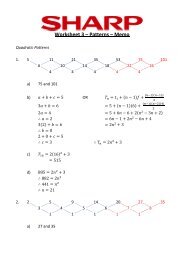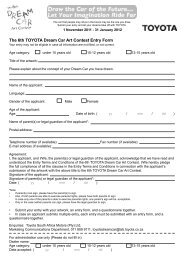curriculum and assessment policy statement (caps) - Department of ...
curriculum and assessment policy statement (caps) - Department of ...
curriculum and assessment policy statement (caps) - Department of ...
- No tags were found...
Create successful ePaper yourself
Turn your PDF publications into a flip-book with our unique Google optimized e-Paper software.
‣ Collect 5 placematsAdd <strong>and</strong> subtract thenumbers with answersup to 5(Number bonds)AdditionSubtraction• Orally solve addition <strong>and</strong> subtraction problems that involve thenumbers 1 to 5KinaestheticExamples5. Teacher calls 3 learners to the front. Learners count them. Teachercalls another 2 <strong>and</strong> asks: How many learners altogether?”3 <strong>and</strong> 2 → 5. (The teacher says: 3 <strong>and</strong> 2 gives 5)6. Teacher packs out 2 chairs. Add 2 more. How many chairs are therenow? 2 <strong>and</strong> 2 → 4.7. Teacher holds up one h<strong>and</strong>. And says: “Count my fingers. If I hide mythumb, how many fingers can you see? 5 take away 1 → 4.8. Let the learners count the fingers on one <strong>of</strong> their h<strong>and</strong>s. Hide yourthumb; how many fingers do you see? 5 take away 1 → 4.1 dayDevelop the concepts“more than”,“less than” <strong>and</strong>“equal to” (fewer than)Concrete using 3-D objectsExamples:1. Count four counters on your desk. Count one on. One on fromfour is?2. Count three counters on your desk. Count two on. Two on fromthree is?3. There were five children on the playground. Two children areleft. How many children went home?4. There were five biscuits in the packet. There is only one biscuitleft. How many did we eat?‣ Order <strong>and</strong> compare collections <strong>of</strong> objects using ‘’more than, lessthan’’ <strong>and</strong> “equal to” up to number 5KinaestheticThe teacher calls three groups <strong>of</strong> learners to the front <strong>of</strong> the class. The onegroup consists <strong>of</strong> three boys <strong>and</strong> two girls. The second group consists <strong>of</strong>three girls <strong>and</strong> three boys <strong>and</strong> the last group consists <strong>of</strong> 4 boys <strong>and</strong> 2 girls.Learners must identify:‣ The group which has more boys than girls.‣ The group which has the same number <strong>of</strong> boys <strong>and</strong> girls.‣ The group which has fewer girls than boys.‣ The group which has more girls than boys.Counters1 day44 | P age
















